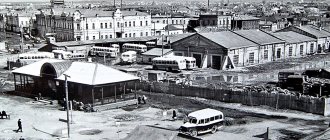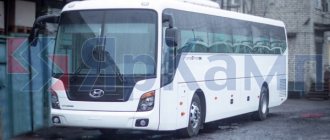The history of the creation of a model based on GAZ 51
The GZA-651 bus has been produced at the Gorky Bus Plant (GZA) since 1949.
In 1952, its production was transferred to the Pavlovsk Bus Plant, where it was produced under the name PAZ-651. The first 5 buses were assembled on August 5, 1952.
Since 1953, the production of GZA-651 under the RARZ-651 . The simplicity of the wooden structure allowed many auto repair enterprises to establish their own production of GAZ-651 buses (sometimes different from the Gorky version) from GAZ-51 and GAZ-51A trucks.
Let's summarize
The title of the article - “Two worlds - two ways of life” - was not put in the title by chance. In one case, there is evidence of many months of painstaking work to bring models to the required level of copycatness, in the other, a hastily released product in pursuit of illusory market leadership. Of course, everyone chooses their own path of development, but I think that an attentive collector, having held both models in his hands, will make his own conclusion about who is the real leader in the market.
Source https://www.gruzovikpress.ru/
Detailed description of the Soviet bus, design, modifications, differences between models
Structurally, the GZA-651 was a hooded truck with a wooden frame sheathed in thin metal. The interior finishing of the “salon” was made with multilayer cardboard. Flooring made , double passenger seats, a passenger door manually opened by the driver using a lever mechanism, as well as the lack of heating - all this was typical for almost all bus models produced at that time. In principle, it was a passenger van mounted on a truck, rather than a stand-alone bus model.
Bus GZA-651. Photo Wikipedia
The PAZ employees did a good job; the new PAZ-651 bus they launched within six months differed from GAZ even in appearance. So the front part of the Gazovsky bus, which copied the hood of a truck, was replaced with a rounded front radiator grille and the same hood cover. additional “turn signals” taken from Pobeda were installed under the windshield on the new bus Such turn signals were mandatory for all passenger cars. A door was installed at the rear of the bus. It was required in case the bus was converted into an ambulance and was included in the project at the request of the military.
At first, the removable blocks of the side panels had a stamped inscription in two lines: “Avtozavod im. Molotov”, later it was replaced by “Pavlovsk Bus Plant named after. Zhdanov" PAZ-651A, located in three lines.
The first five copies of Pavlovsk buses were manufactured on August 5, 1952. At the same time the design of the bus was constantly changed , so in 1955 a modification was created, equipped with a body frame made entirely of metal. It received the designation PAZ-651A . Thin-sheet low-carbon metal was used as construction materials for this bus . Omega-shaped body parts were made from it, which made it possible to achieve good strength with low weight. Subsequently, all buses of the Pavlovsk plant were produced all-welded precisely at the site that was created for the manufacture of the PAZ-651A body.
Later, when the welding shop developed its production capacity, the frame and frame of the machine began to be made welded. In 1957, the first copy of a completely all-welded bus, the auto shop 659, went into production.
It is worth noting that initially the first Pavlovsk bus had the designation PAZ-651, but in internal technical correspondence at the plant it was designated as GZA-651, and only after welded components appeared in its design did it receive the name PAZ- 651.
In 1958, a new car, the PAZ-652, ; therefore, it was decided to transfer the production of the old bus to the newly created Kurgan Bus Plant. At the same time, this bus was produced at PAZ until it was discontinued in 1961. In total, during the production of these vehicles, copies of the PAZ-651 and PAZ-651A, as well as 24 thousand units of all-metal PAZ-651A, came off the assembly line.
All-terrain bus KAvZ-663. Photo Wikipedia
In addition to the basic model, the plant also produced special modifications of this bus:
- PAZ-651V (sanitary),
- PAZ-657 (bread van),
- PAZ-659 (automatic shop),
- PAZ-659B (epidemiological laboratory),
- PAZ-661 (clothes van),
- PAZ-661B (cargo van),
- PAZ-654 (headquarters),
- PAZ-655 (collector).
Since January 1958, production of the PAZ-651A bus began in parallel at the Kurgan Bus Plant under the designation KAvZ-651A. Production at PAZ continued until 1961. From 1971 to 1973, a modification of the KAvZ-651B was produced in Kurgan, the only difference of which was the presence of a heater in the cabin.
Based on the GAZ-63 car, the KAVZ-663 all-terrain bus was produced.
Miniature keep your step!
In March 2014, SSM launched the Kuban-G1A1-02 bus model on the Russian market at a price of 3,350 rubles. It should be noted that in the 1990s, a plastic model of this bus was produced by the Krasnodar enterprise Kompanion. It looked rather rough due to the chosen technology and materials for production. However, due to the lack of an alternative, collectors of those years accepted it very favorably, and it is still in many collections. Let’s not compare these two “Kuban” models - the copyability of a model is still determined by its similarity to the prototype, and not to another model.
The first thing you should check is that the dimensions of the model correspond to the 43rd scale declared by the manufacturer.
For comparison, let’s take the three main overall dimensions of a bus (length/height/width) given in Denis Dementyev’s article “The Southern Outpost of Bus Manufacturing.” Measurement results of the Kuban-G1A1-02 bus
| Size of a real bus, mm | Ideal size in scale 1:43 (rounded), mm | Actual size of the model produced by SSM, mm |
| Length – 6870 | 159 | 158 |
| Width – 2450 | 57 | 56 |
| Height – 2835 | 66 | 61 |
It is easy to see that SSM made the model significantly lower than it should be. It cannot be said that the 5 mm difference in these measurements is very noticeable on the “live” model (although the manufacturer’s error was 8% in height!), but recalculating the same lost 5 mm of the model’s height into the real size gives a “shrinkage” in the height of the real bus by more than twenty centimeters. Somehow this is too much.
Well, the model did not pass the first, simplest test, and now it will have to undergo a more biased inspection by a collector dissatisfied with the purchase.
So, the front of the Kuban. Both hood openings appear to be oversized in width, which is a consequence of the hood being wider than it should be, and the larger lower opening is also oversized in height. If you look at the model strictly from the front, you can see that the profile of the model is not conveyed quite correctly - close to the prototype, but still it could be better. Here we also note the simplified factory emblem and the incredible thickness of the handle under the wipers. Headlights and sidelights attract attention. The first ones are clearly smaller than they should be, which is why the second ones look too big. At the same time, the manufacturer (let's give him his due) nevertheless made an attempt to separate the orange and white sections of the sidelights, but the result of this attempt does not look very convincing. The mirrors are made a little smaller than they should be, and therefore look a little dim. Purely subjective, the rounding of the windshields was done a little incorrectly - too “angular”. But the rear of the bus does not raise any special questions - “Kuban” is quite recognizable, although the manufacturer’s rear lights were not very successful.
Even without disassembling the model and looking at the interior through the glass, it is not difficult to see the cyclopean-thick wall behind the driver, oversized by about three times in thickness. The dashboard looks very strange without highlighting the instruments in at least a different color - usually this level of detail can be seen on hundred-ruble toy cars. The steering wheel bracket was clearly borrowed from the same category of children's toys. Against the background of these shortcomings, comments about the simple seats, their careless painting and the presence of remnants of sprues on them, the absence of handles on the emergency hatches on the inside will seem, perhaps, to be pure nit-picking.
The wheels of the model raise a separate question - we know well that the GAZ-53 wheels were mounted on six studs. The manufacturer has his own vision on this matter - in his opinion, the front discs were, indeed, attached to six studs, but on the rear discs they used all eight. By the way, the rims of the model as a whole, even if you do not take into account the strange number of mounting studs, are far from ideal. The spare wheel is fixed, as it should be, in the rear overhang of the bus, but the manufacturer saved money and did not create a separate mold for the “spare”, and for this reason it is depicted as one of the rear wheels with a hub and eight studs sticking out of it. Well, since we already looked under the bus, we note that the bottom is made ugly. It's not even a matter of blatantly protruding mounting screws - the model's manufacturer simply completed the entire bottom as a single part, without even worrying too much about the semblance of a copy. And the absence of a battery compartment, the design of the exhaust system, the front beam and the rear axle will certainly serve as a separate reason for curses from self-respecting collectors against the manufacturer. And it cannot be said that they would be wrong - given the high cost of the model, the manufacturer could have made more efforts to give the model an authentic look.
To be fair, we note that at least collectors were lucky with the coloring of the model - the manufacturer chose one of the real paint schemes for the model.
Basic information, characteristics
Manufacturer/manufacturer where the equipment is produced/manufactured. Pavlovsky Bus is a Soviet and Russian manufacturer of small and medium class buses. Located in the city of Pavlovo, Nizhny Novgorod region. Part of the GAZ group. Since 2005, bus production has been carried out by PAZ LLC, a 100% subsidiary of Pavlovsky Bus PJSC.
The Gorky Bus Plant (abbreviated as “GZA”) is a Soviet automobile manufacturing enterprise, a manufacturer of buses and small-scale modifications of GAZ cars. Also known as State Automobile Assembly Plant No. 1. He was located in Nizhny Novgorod (from 1932 - Gorky) in the Kanavinsky district. Abolished in 1952.
"KAvZ" (formerly the Kurgan Bus Plant named after the 60th anniversary of the USSR (KAvZ)) is a manufacturer of buses in Russia. Located in the city of Kurgan. Since 2005, it has been part of the Buses Division of the GAZ Group holding, and since 2001, it has been part of the GAZ Group. KavZ LLC is a subsidiary of GAZ OJSC.
RARZ (Riga Auto Repair Plant No. 2), as well as many other auto repair plants: Tartu (Estonia), Moscow, Shchekino (Tula region), Skuratovo (Tula region), Kiev (Ukraine), Semyonov (Gorky region), Tosno (Leningrad region) ), Kaunas (Lithuania), Apsheronsk (Krasnodar region).
Purpose. Depends on the modification, the basic model is for short country routes or business needs.
Class. Small.
Body type. Bonnet.
Specifications
- Fuel type. Petrol.
- Fuel tank capacity, l. 90.
- Curb and technically permissible weight, kg. 3750 and 5550.
- Load on front/rear axle based on technically permissible weight, kg. 1470 / 4080.
- Minimum turning radius, m. 8,1.
- Front approach angle/rear departure angle, degrees. 37 / 16.
- Brake system. With hydraulic drive.
Engine/powertrain characteristics
- Type. Petrol.
- Number and arrangement of cylinders. 6, in-line.
- Working volume, cubic cm. 3485.
- Engine power, hp/min. 70.
- Maximum torque, Nm/min. 205.
- Engine location. Anterior, longitudinal.
- Checkpoint. Manual transmission 4.
- Control fuel consumption at 60 km/h, l/100 km. 22.
- Maximum speed, km/h. 60-70.
- Pre-heating. Absent.
Dump truck GAZ-93
Dump truck GAZ-93
was manufactured on the GAZ-51D chassis. The metal box-shaped body with a volume of 1.65 m³ had a folding tailgate. To transport lightweight cargo, the side walls of the body had holes and brackets for attaching the racks of the enlarged sides. The lifting mechanism is hydraulic, controlled from the cabin, combined with an oil pump, with a horizontal cylinder, the forces from which are transmitted to the platform through two intermediate rods. The horizontal arrangement of the hydraulic cylinder made it possible to bring the pump closer to the gearbox and use only one drive roller. The maximum pressure in the hydraulic system was 15 kgf/cm2. The GAZ-93, designed at the Ural Automobile Plant, was originally going to be produced at the Novosibirsk Automobile Plant (NAZ), but due to its repurposing, production of the dump truck was launched at the Odessa Automobile Assembly Plant (OdAZ).










